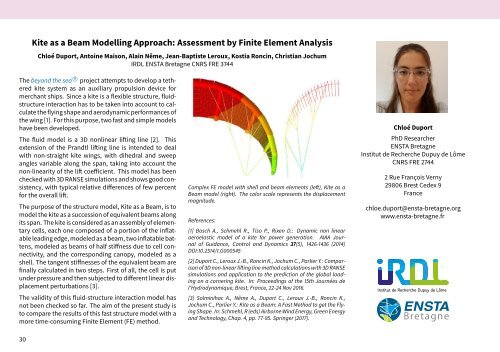Airborne Wind Energy Conference 2017 Book of Abstracts
You also want an ePaper? Increase the reach of your titles
YUMPU automatically turns print PDFs into web optimized ePapers that Google loves.
Kite as a Beam Modelling Approach: Assessment by Finite Element Analysis<br />
Chloé Duport, Antoine Maison, Alain Nême, Jean-Baptiste Leroux, Kostia Roncin, Christian Jochum<br />
IRDL ENSTA Bretagne CNRS FRE 3744<br />
The beyond the sea R⃝ project attempts to develop a tethered<br />
kite system as an auxiliary propulsion device for<br />
merchant ships. Since a kite is a flexible structure, fluidstructure<br />
interaction has to be taken into account to calculate<br />
the flying shape and aerodynamic performances <strong>of</strong><br />
the wing [1]. For this purpose, two fast and simple models<br />
have been developed.<br />
The fluid model is a 3D nonlinear lifting line [2]. This<br />
extension <strong>of</strong> the Prandtl lifting line is intended to deal<br />
with non-straight kite wings, with dihedral and sweep<br />
angles variable along the span, taking into account the<br />
non-linearity <strong>of</strong> the lift coefficient. This model has been<br />
checked with 3D RANSE simulations and shows good consistency,<br />
with typical relative differences <strong>of</strong> few percent<br />
for the overall lift.<br />
The purpose <strong>of</strong> the structure model, Kite as a Beam, is to<br />
model the kite as a succession <strong>of</strong> equivalent beams along<br />
its span. The kite is considered as an assembly <strong>of</strong> elementary<br />
cells, each one composed <strong>of</strong> a portion <strong>of</strong> the inflatable<br />
leading edge, modeled as a beam, two inflatable battens,<br />
modeled as beams <strong>of</strong> half stiffness due to cell connectivity,<br />
and the corresponding canopy, modeled as a<br />
shell. The tangent stiffnesses <strong>of</strong> the equivalent beam are<br />
finally calculated in two steps. First <strong>of</strong> all, the cell is put<br />
under pressure and then subjected to different linear displacement<br />
perturbations [3].<br />
The validity <strong>of</strong> this fluid-structure interaction model has<br />
not been checked so far. The aim <strong>of</strong> the present study is<br />
to compare the results <strong>of</strong> this fast structure model with a<br />
more time-consuming Finite Element (FE) method.<br />
30<br />
Complex FE model with shell and beam elements (left), Kite as a<br />
Beam model (right). The color scale represents the displacement<br />
magnitude.<br />
References:<br />
[1] Bosch A., Schmehl R., Tiso P., Rixen D.: Dynamic non linear<br />
aeroelastic model <strong>of</strong> a kite for power generation. AIAA Journal<br />
<strong>of</strong> Guidance, Control and Dynamics 37(5), 1426-1436 (2014)<br />
DOI:10.2514/1.G000545<br />
[2] Duport C., Leroux J.-B., Roncin K., Jochum C., Parlier Y.: Comparison<br />
<strong>of</strong> 3D non-linear lifting line method calculations with 3D RANSE<br />
simulations and application to the prediction <strong>of</strong> the global loading<br />
on a cornering kite. In: Proceedings <strong>of</strong> the 15th Journées de<br />
l’Hydrodynamique, Brest, France, 22-24 Nov 2016.<br />
[3] Solminihac A., Nême A., Duport C., Leroux J.-B., Roncin K.,<br />
Jochum C., Parlier Y.: Kite as a Beam: A Fast Method to get the Flying<br />
Shape. In: Schmehl, R (eds) <strong>Airborne</strong> <strong>Wind</strong> <strong>Energy</strong>, Green <strong>Energy</strong><br />
and Technology, Chap. 4, pp. 77-95. Springer (<strong>2017</strong>).<br />
Chloé Duport<br />
PhD Researcher<br />
ENSTA Bretagne<br />
Institut de Recherche Dupuy de Lôme<br />
CNRS FRE 2744<br />
2 Rue François Verny<br />
29806 Brest Cedex 9<br />
France<br />
chloe.duport@ensta-bretagne.org<br />
www.ensta-bretagne.fr


